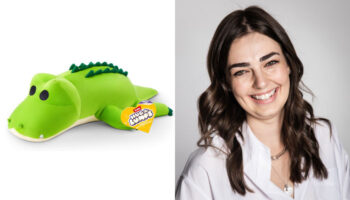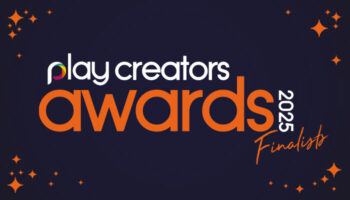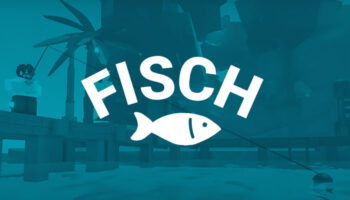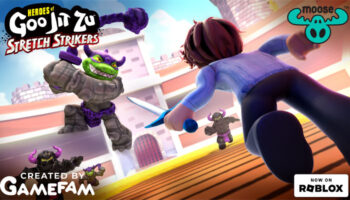Sneaky Snacky Squirrel Game inventor Riley Wilkinson on developing ideas – and his new course: My Toy Pitch

Riley, lovely to meet you! I always feel it’s too obvious a place to start, but it does make sense: with which toys and games did you play growing up?
It’s so nice meeting you as well! These were my favourites: Fisher-Price Little People, including a castle, garage, house, and the schoolhouse. Fisher-Price also put out Woodseys Family which was great. And it wasn’t mine – it was my sister’s – but I liked the EZ Bake Oven! I loved Lite Brite, The Crayola Caddy and My Big Wheel…
The sit-and-ride bike?
Right! I also used to take my stuffed animals and line them up in chairs… I’d pretend I was their teacher and even gave them little scraps of paper with stickers on them. Finally I had a wood-peg puzzle that my mom made with her jigsaw. She made a ladybug and the letters of my name.

Lovely! So a very play-filled childhood. How, then, did that become work? How did you come to be working in the industry?
At 21, my first job was in LA as a designer and art director for the Frank Schaffer imprint of McGraw-Hill Children’s Publishing. I designed and art-directed posters, catalogue covers, classroom decorations and preschool chipboard puzzles…
You physically designed wooden puzzles?
Exactly. We hand-drew the die cuts of our wood puzzles back then… I remember rounding out the piece edges in pencil on vellum for a counting caterpillar puzzle. From there, I spent the next 20+ years creating all sorts of toys, game, and activities for toy companies. It’s all I’ve ever done.
And among that back catalogue, you have the The Sneaky Snacky Squirrel Game. What’s the basic idea?
The heart of the game is ‘Sneaky’… This is a little hand squeezer, like a muscle developer, in the shape of a squirrel. Kids use this, aiming to be first to harvest acorns in five different colours. They fill their tree stumps with help of Sneaky! As they spin the spinner, kids can collect acorns, steal them or even lose them in a storm.

There’s quite a bit of development value in there, right? It develops tactical thinking, hand-eye coordination, fine motor skills, and more. How did it come about?
In a way, it goes back to those stuffed animals! As a kid, I wanted to live in the little worlds my sister and I created with our toys. Later, while at Educational Insights in LA, I took an illustration course taught by Clayton Brothers at Art Center. I began drawing animals that create little homes, inspired by some forest memories I had from childhood. Christian Clayton told me to focus on that obsession…
Focus on that obsession? I quite like that…
His exact words! He told me to keep drawing those memories, so I kept drawing squirrels and beavers. Then I made acorns and glued them to pieces of barn wood. Underground tunnels and woodgrain became this obsession. This got me thinking about little woodland toys I had in Pennsylvania as a kid. I wanted to give kids the chance to “be” an animal in their own little house.
So you were trying to create a game where kids had to be a bit more immersed than usual?
Yes. Really, I wanted to create a game that felt like a doll and a dollhouse. Eventually, I made a little squirrel house out of plaster gauze, then started thinking about how a child could pretend to become the squirrel. With a pair of tongs and some clay, I made a little squirrel-shaped squeezer and brought it into the office. I sketched out a little tree box and told the team I wanted the squirrel to gather dinner to win the game. So really, it all started with childhood memories of becoming the character in a toy.

What, for you, was the hardest part of developing it and getting it to market?
I really wanted the game to be a standing tree on store shelves. My general manager, Lisa Guili, agreed. We didn’t want Sneaky to live in a square box! He needed to live in a tree. A retailer said the box had to fit into their planogram as a square; they didn’t want a shaped box.
Interesting. They didn’t see it selling more as a tree?!
Right. So the hardest point was standing behind my creative vision. I really felt the game would simply be one more SKU if it lost the personality we’d given it. It’s almost like I’m talking about a real squirrel here! I KNEW that kids would see this game as a little playset if it were in a tree box!
It’s interesting you word it that way. Whenever I hear anyone talking about a SKU count, I wonder if they’re still in touch with the audience. People get into toys and games talking about incredible play experiences – not SKUs! When does it flip?! Rhetorical question… Anyway, you persevered?
We persevered, and we were right. The tree-shaped bow looks incredible! In fact, the Italian artist Lucia Gaggiotti created such beautiful art for the game. Her art makes the game so special. I spotted her work on a cookie box at Starbucks… It took me a few months to get in touch with her. And then Cliff Jackson sculpted a 3D Sneaky from clay, based on Lucia’s character art.

And to your earlier point, you feel this creates a more interesting world for kids? It’s more like a dollhouse?
Absolutely! In fact, I’ll never forget a picture a parent posted on Instagram. Their daughter had taken a little shoebox, made a bed out of it, nestled Sneaky in it, and given him a little bedspread made out of a dish towel. That little girl saw Sneaky as her friend.
Lovely! Okay… Now, you recently started running a course: My Toy Pitch. Tell me about that.
For My Toy Pitch, I’ve teamed up with my pal Lilla Rogers, one of the top art agents in the world. Outside of running Lilla Rogers Studio, she’s created the Make Art That Sells courses for artists all around the world.
So Lilla is experienced running similar courses for art?! You know what, I’ll link to that course at the end of the piece. Sounds extraordinary!
Lilla somehow sees into the future and knows what’s next! For My Toy Pitch, our trend boards and product boards are up on my studio walls… I’m just so inspired by Lilla’s vision. Students will feel like they’ve visited toy stores from around the world by the time they’ve created their 5th concept pitch.

Great! And what’s on the course? What can students expect?
My Toy Pitch immerses students in four toy categories: pretend play, games, characters, and playsets. Lilla and I perform video “improv inventions,” hold live student reviews, share industry Q&A interviews, and give students piles of inspiration. We cull through toys from all over the world and show students what we love and why. Each week, I run through a bazillion examples of beautiful, well-made, quirky toys and games that represent where we see the market going.
Well, let me ask you this if you had to give first-time inventors three top tips about pitching ideas, what would you say?
First, work on what you love the most. If it doesn’t inspire you, let it rest or toss it – and move to a concept that does. People buy your joy, as my friend Lilla Rogers says. That excitement will show up in your work and in a product kids will love. That joy is obvious when you ask someone to playtest your idea. I know this sounds very cosmic, because it is!
I guess that goes back to what we said earlier about SKU’s and obsessions. So… Second?
Second, learn everything you can about your concept’s toy category. Who makes toys in this category? What sells? What doesn’t? What do parents and gift-givers say about toys currently in the category? Does your concept exist? If not, why not? If it does, what unforgettable twist will you bring to it?

Third, I’d advise people to record videos and take pictures of their entire process. Even if nobody has time to look at it, capture it anyway. You never know if a bit of that work can be used to inspire a new concept or help support the one you’re pitching. At a minimum, you can look back and see how you’ve progressed and how your concept has evolved. I’ll add one more bonus tip if I can?
Of course!
In a way, this is the most important one. It’s to make yourself a mockup of some kind – and pretend it’s your toy. How fun! You’ve just created your first toy!
Brilliant. That’s wonderful. Thank you. We need to start wrapping things up, Riley, but let’s give you a good plug: where can people find out more about my toy pitch?
It’s quite a long address: https://makeartthatsells.com/online-courses/my-toy-pitch-2021/ – our first class starts July 5th.
Well, we’ll make that a link! Finally, then, what’s the most interesting thing on your desk or in your office?
The previous owners of my house left behind an old rolltop desk with little drawers. I labeled the drawers: binder clips, index cards, junk, and wishes. I’d wanted a rolltop desk my whole life! In a way, it’s like a little secret fort filled with tiny nooks and hideaways. Hey, this sounds like a playset!
And so it begins! Wonderful. Thank you again, Riley. Best of luck to you, Lilla and the students on your course.

—
To stay in the loop with the latest news, interviews and features from the world of toy and game design, sign up to our weekly newsletter here


























